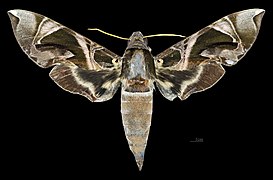Daphnis hypothous
| Daphnis hypothous | ||||||||||||
|---|---|---|---|---|---|---|---|---|---|---|---|---|

Daphnis hypothous |
||||||||||||
| Systematics | ||||||||||||
|
||||||||||||
| Scientific name | ||||||||||||
| Daphnis hypothous | ||||||||||||
| ( Cramer , 1780) |
Daphnis Hypothous is a butterfly ( moth ) of the family of moth (Sphingidae). The range of the species covers large parts of Southeast Asia as well as New Guinea and the north of Australia .
features
butterfly
The moths reach a wingspan of 86 to 120 millimeters. The forewings are dominated by a dark green pattern, which consists of curved spots bordered by differently colored cream-colored to brown stripes or spots. A stripe approximately at the level of the first third of the forewing is conspicuous and runs at the same height between the first two segments of the abdomen . There is a circular white spot on the tip of the forewings. The hind wings are dark green and brown in color and have a faded, slightly curved, light brown band around the middle of the wing.
The thorax and the first two abdominal segments are colored dark green, the head and collar are dark purple-brown. The legs are cream-colored like the antennae .
Caterpillars
The caterpillars reach a body length of 60 to 100 millimeters and have a pale green or rarely pale red basic color. The thorax is darker than the abdomen. On the side of the back, from the second thoracic segment to the base of the anal horn , a white longitudinal line runs on both sides of the body, which merges into orange at the beginning and end. The white line along the abdomen is lined with dark green upwards and light blue downwards. There are also oblique dark green stripes and fine yellow dots along the sides of the body. The sides of the third thoracic segment each have a large, blue eye-spot . The slightly curved, short anal horn is brown and pustular. Shortly before pupation, the body of the caterpillars turns purple with dark red spots.
Doll
The pupa is also similar to that of the oleander hawk, but has a fine black line along the proboscis , the head and along the stomach side to the cremaster . This is wide and triangular in shape and ends in a double point. A dark band runs at the level of the spiracles , which is parallel to two other dark bands on the abdomen of the abdomen.
Similar species
Daphnis hypothous can be confused with the oleander hawk ( Daphnis nerii ). Its forma nigra in particular looks very much like it. A definite distinguishing feature is the white round spot on the wing tip, which the oleander hawk lacks.
Occurrence
The range of the species covers large parts of Southeast Asia as well as New Guinea and the north of Australia . The subspecies D. h. crameri occurs in the south and north of India , in Sri Lanka , Nepal , Myanmar , in the south of China , in Taiwan , Thailand , Malaysia and in the west of Indonesia . The area of the subspecies D. h. pallescens includes New Guinea, the Solomon Islands, and northern Australia.
Daphnis hypothous flies as a migratory butterfly beyond the limits of its distribution area and then also occurs in northern China and southern Japan . In the Middle East the species is found occasionally, very rarely it also flies into the further western areas of the Palearctic , but is mostly confused with the much more common oleander hawk to the west of its range. One individual was found in Scotland at the end of the 19th century , which is believed to have been brought in as a doll with cargo.
Way of life
The moths are extremely fast fliers and are attracted by both artificial light and strongly smelling nectar springs. Beyond that, nothing is known about their way of life. Within its range, the species continuously produces several generations per year.
The round and light green eggs are very similar to those of the oleander hawk. The caterpillars that hatch from it prefer to live on plants that grow near water. The caterpillars feed on woody reddish growths (Rubiaceae). In India, Cinchona ( cinchona ), wendlandia and Uncaria detected as food crops. Information about caterpillars found on oleander ( Nerium oleander ) is probably based on confusion with caterpillars of the oleander hawk.
Pupation takes place on the ground in a loose cocoon between plant parts. The pupa does not overwinter.
swell
Individual evidence
- ↑ Sphingidae of the Western Palaearctic. AR Pittaway, accessed March 18, 2008 .
- ^ Sphingidae of the Eastern Palaearctic. AR Pittaway, accessed March 18, 2008 .
literature
- AR Pittaway: The Hawkmoths of the western Palaearctic. Harley Books 1993, ISBN 0-946-58921-6


